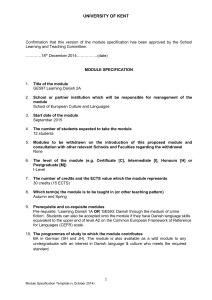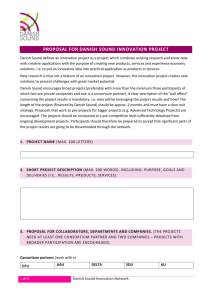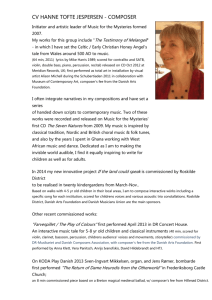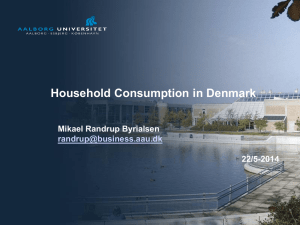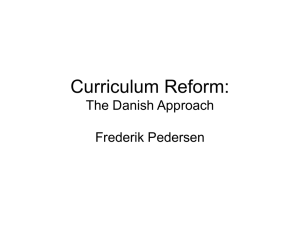University of Kent
advertisement
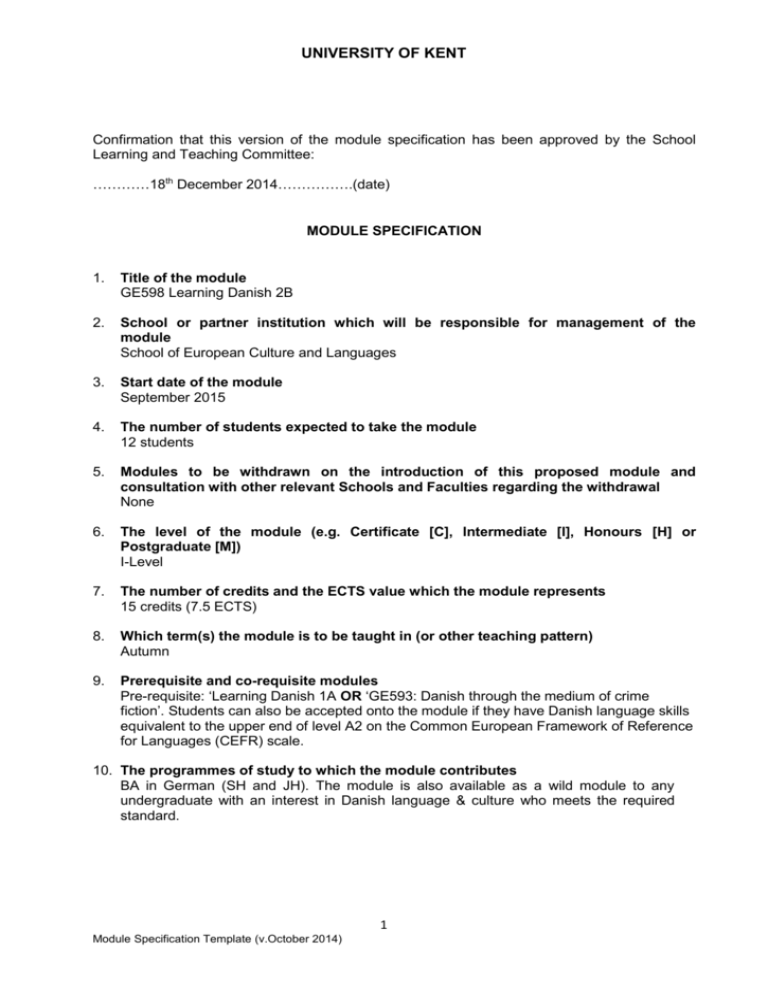
UNIVERSITY OF KENT Confirmation that this version of the module specification has been approved by the School Learning and Teaching Committee: …………18th December 2014…………….(date) MODULE SPECIFICATION 1. Title of the module GE598 Learning Danish 2B 2. School or partner institution which will be responsible for management of the module School of European Culture and Languages 3. Start date of the module September 2015 4. The number of students expected to take the module 12 students 5. Modules to be withdrawn on the introduction of this proposed module and consultation with other relevant Schools and Faculties regarding the withdrawal None 6. The level of the module (e.g. Certificate [C], Intermediate [I], Honours [H] or Postgraduate [M]) I-Level 7. The number of credits and the ECTS value which the module represents 15 credits (7.5 ECTS) 8. Which term(s) the module is to be taught in (or other teaching pattern) Autumn 9. Prerequisite and co-requisite modules Pre-requisite: ‘Learning Danish 1A OR ‘GE593: Danish through the medium of crime fiction’. Students can also be accepted onto the module if they have Danish language skills equivalent to the upper end of level A2 on the Common European Framework of Reference for Languages (CEFR) scale. 10. The programmes of study to which the module contributes BA in German (SH and JH). The module is also available as a wild module to any undergraduate with an interest in Danish language & culture who meets the required standard. 1 Module Specification Template (v.October 2014) UNIVERSITY OF KENT 11. The intended subject specific learning outcomes On successful completion of this module, students will be able to demonstrate proficiency in the Danish language equivalent to median range of the B1 level (Independent User) on the CEFR scale. Students who successfully complete the module will have acquired the following language skills relating to the main topics outlined under point 13. 11.1. Listening Students can begin to understand the main points of clear standard output on familiar matters that have been rehearsed. 11.2. Reading Students can read texts that consist mainly of highfrequency every day or university-related language. 11.3. Speaking Student can enter a prepared conversation with a (Danish) native speaker and talk about familiar topics (everyday life, family hobbies, interests, work and travel). 11.4. Writing Students can connect phrases in a simple way to describe events, hopes and ambitions. Students can also in a simple way narrate a story or the plot of a film or a book. 11.5. Grammar Students can use reasonably accurately a repertoire of frequently used patterns associated with fairly predictable situations. Students for example know all tenses and also have knowledge of irregular verbs and inversion. 11.6. Pronunciation Students control all Danish sounds and pronunciation is generally clear enough to be understood despite a noticeable foreign accent. 12. The intended generic learning outcomes On successful completion of this module, students will be able to: 12.1. Independently identify knowledge gaps and are able to use appropriate, advanced resources (including online tools) to fill these. 12.2. Manage workload and organise their time efficiently. 12.3. Transfer their skills of writing cogent, well-structured text and developing arguments when writing in other languages, including their mother tongue. 12.4. Participate in conversation and discussion, listening to, respecting and complementing the contributions of others. 12.5. Use strategies for paraphrasing and circumlocution. 12.6. Reflect on the target culture and their own culture in an intercultural context. 13. A synopsis of the curriculum This module is a follow-up module, which builds on the knowledge of Danish language and culture acquired in Learning Danish 1A/1B. It consolidates students’ existing competences in the four main language-learning areas: reading, writing, speaking and listening. The language teaching will be delivered communicatively and will introduce increasingly complex Danish grammar, syntactical structures, semantic specificities and pronunciation subtleties. Topics will relate closely to students’ everyday life as university students and purpose-made material will enable students to participate in conversations about their study area, working methods, life on campus, sport and leisure activities. 14. Indicative Reading List Garde, Anna. 2011. Danish Dictionary: Danish-English, English-Danish. (Routledge Bilingual Dictionaries) or equivalent. Langaard, Birte. 2011. Pæredansk (Copenhagen: Gyldendal) 2 Module Specification Template (v.October 2014) UNIVERSITY OF KENT Lundskær-Nielsen, Tom, and Philip Holmes. 2011. Danish: An Essential Grammar (London: Routledge) A high quantity of purpose-produced materials will form the basis of the module’s resources. These will be made available to students via the Moodle page. In addition, online (text, audio and video) material will be used (Online dansk, Dansk på arbejde and Nyidanmark). 15. Learning and Teaching Methods, including the nature and number of contact hours and the total study hours which will be expected of students, and how these relate to achievement of the intended module learning outcomes This module will be taught by means of 3 hours of seminars and a 1-hour conversation workshop for ten weeks, which amount to 40 (80) total contact hours. Seminar hours: 30 hours Conversation hours: 10 hours Independent study hours: 110 hours Total study hours: 150 hours The seminar hours will be in small seminar groups to allow for close involvement and interaction. These will combine individual, pair and group work, which will develop speaking, reading, listening and writing skills (11.1-11.6, with lesser focus on 11.1,11.3; 12.1-12.6). There will be language homework (11.1-11.2, 11.4-11.5, 12.1-12.6); and regular formative written assessments throughout the term(s) (11.4-11.5, 12.1-12.3). Students will be highly encouraged to form study groups in which they can practise vocabulary, communicate in Danish, develop understanding of grammar, etc. (11.111.6, 12.1-12.2, 12.4-12.6). The weekly conversation hour focuses solely on oral understanding and production (11.1, 11.3, 11.6, 12.1, 12.4 and 12.6). 16. Assessment methods and how these relate to testing achievement of the intended module learning outcomes 100% coursework: A) 1 Oral test (10 minutes, 20%) Testing learning outcomes 11.1, 11.3, 11.5-6, 12.4-6. B) 8 written take-home assignments of approximately 150 words (4x5%=20%) Testing learning outcomes 11.10-11, 12.1, 12.3 and 12.5-6. C) 1 In-class listening test (15 minutes, 20%) Testing learning outcomes 11.1, 11.4, 12.2. D) 1 In-class written test (1 hour, 40%) Testing learning outcomes 11.2, 11.4-5, 12.2-3 and 12.5-6. 17. Implications for learning resources, including staff, library, IT and space A part-time member of staff may be needed to teach this module. 18. The School recognises and has embedded the expectations of current disability equality legislation, and supports students with a declared disability or special educational need in its teaching. Within this module we will make reasonable adjustments wherever necessary, including additional or substitute materials, teaching modes or assessment methods for students who have declared and discussed their learning support needs. Arrangements for students with declared disabilities will be made on an individual basis, in consultation with the University’s disability/dyslexia support service, and specialist support will be provided where needed. 19. Campus(es) or Centre(s) where module will be delivered: Canterbury. 3 Module Specification Template (v.October 2014)
